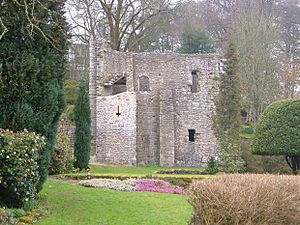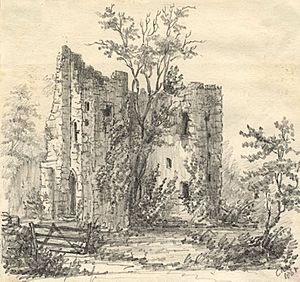Gidleigh Castle facts for kids
Gidleigh Castle was a large house called a manor house in the area of Gidleigh, England. It is located on the edge of Dartmoor, about 3 kilometers (2 miles) north-west of Chagford, a town in Devon.
Contents
What Was Gidleigh Castle?
Even though it's called a castle, Gidleigh Castle was more like a very strong manor house. A manor house was the main home of a lord who owned a large area of land. This building was not in a good spot for defense, as it was built on a slope. However, it had very thick walls, about six feet wide, and strong bars for its doorways.
The design of Gidleigh Castle was quite similar to Okehampton Castle, which was built around the same time. It's possible that the same master builder worked on both places. Both buildings used a sandy rock called dolomite from quarries nearby.
What Remains Today?
Today, only a small ruined tower of the castle is left. This tower has a basement area called an undercroft and a main room above, which was either a hall or a private room called a solar. A staircase inside the west and south walls connects these two levels. There was also an outdoor staircase on the east wall, but most of it has fallen down.
The fireplace in the main room has been changed a lot over time. It has two windows next to it, and one of them even had seats. It's not clear if there was another timber or stone hall connected to the north side of the tower.
Who Lived at Gidleigh Castle?
The Prouz family owned the land of Gidleigh from the late 1100s. The castle was probably built by Sir William Prouz, who was the last male in the main line of his family. He passed away in 1316.
His only daughter, Alice Prouz, inherited the castle. She married Sir Roger de Moels. Alice and Roger had three daughters. These daughters shared Alice's large inheritance, which included Gidleigh manor and its castle. Gidleigh later went to one of these daughters, Alice de Moels, who was married to John Daumarle.
Changes in Ownership
After Sir John Daumarle died around 1393, his inheritance was claimed by Joan Cokyn. She was a granddaughter of his sister. Joan later passed away in 1454, and her daughter inherited the property, bringing it to the Coode family.
In 1631, Henry Battishill owned the manor. Later, in 1683, Bartholomew Gidley bought it. By this time, the castle was probably already falling apart. Bartholomew Gidley used some of the stones from the old castle to build a new house nearby, which he called Castle House.
The Gidley family owned the property until 1772. After that, Henry Rattray became the Lord of the Manor through marriage. When he died in 1795, the manor went to Rev. Arthur Whipham. In 1912, the castle was owned by Arthur's grandson, A. Guy Whipham, who lived at the nearby Gidleigh Park.
Protecting the Ruins
Around 1890, the castle ruins were quite stable. However, by 1918, new building work nearby caused problems. The ground was leveled for a new house's garden, which damaged the castle's foundations. This led to the collapse of a turret staircase and the main entrance arch, causing a lot of other damage.
Experts from the government checked the condition of the ruins in 1960. Because of their reports, repair and strengthening work was done in the 1990s and 2000s. Since 1967, the ruins have been a "listed building" at Grade I. This means they are considered "of exceptional interest" and are very important historically.



